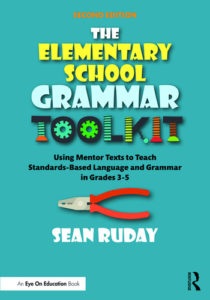Mentor Texts Can Help Kids Grasp Grammar
The Elementary School Grammar Toolkit: Using Mentor Texts to Teach Standards-Based Language and Grammar in Grades 3-5
By Sean Ruday
(Routledge/Eye On Education, 2020 – Learn more)
Reviewed by Kathleen Palmieri

Picture creativity and imagination flowing freely as young authors’ hands wave in the air wanting to share a story idea. The classroom is alive with excitement as students brainstorm ideas, share thoughts, and create incredible stories.
Then the energy in the room transitions into the dreaded hum of silence as the teacher begins to introduce the grammar lesson for the day. Somehow adjectives, nouns, verbs, or talking about sentence structure just aren’t that exciting to kids.

Ruday uses a “boots on the ground approach by exploring specific strategies and activities teachers can use to introduce students to these grammatical concepts, improve metacognition of them, and enable students to apply the concepts to their own writing.” (page 7).
Beyond worksheets for grammar
Many schools have a prescribed curriculum that does nothing more than provide a “worksheet” approach to grammar lessons. Ruday offers the practice of using a mentor text as a tool to help students connect as they learn proper writing conventions. He also offers snapshots from classrooms showing this method in use.
For example, in chapter 2 Ruday discusses teaching subject-verb agreement. He writes, “The essence of subject-verb agreement is that singular subjects have singular verbs and plural subjects need plural verbs.” (page 23) Add to this the use of irregular verbs, and this concept can lead to confusion for students. “Subject-verb agreement is an important tool for creating clear and effective writing.” (page 27) Using mentor texts can help teach this important writing concept as the following examples will demonstrate.
Working with the idea of using first person, second-person, and third-person narration, Ruday shows how the novel The Parker Inheritance by Varian Johnson is used “to illustrate the importance of subject-verb agreement.” Sentences are strategically chosen from the book, such as “The library was down the street” (Johnson, 2018, page 5) rather than “The library were down the street” to illustrate the point that the meaning would be unclear and would cause confusion. (page 27)
Another popular kid’s book, Diary of a Wimpy Kid by Jeff Kinney, is used in Ms. Jay’s third grade classroom to direct students’ attention to subject-verb agreement in sentences. On page 29 Ms. Jay uses the sentence, “Dad walked down to the basement to chew Rodrick out, and I tagged along.” (Kinney, 2007, pg. 12) Both examples provide a way for students to connect to the lesson using a familiar mentor text.
Figuring out sentence structure
Next, an example of using a mentor text to teach “Simple, Compound, and Complex Sentences” can be found in chapter 4, using the book Stella Diaz Has Something to Say by Angela Dominguez (2018). “This book features a range of sentence types, making it useful for demonstrating why writers use certain sentences for particular effects.” (page 50). Using this text, the teacher is able to illustrate using a simple sentence, “Pancho is my betta fish” (Dominguez, page 4), showing one independent clause to make a point.
Then the teacher uses an example of a compound sentence, “The whole group giggles for a second, and the teachers hush us.” (Dominguez, page 34). The teacher is then able to point out that the sentence “contains two independent clauses, joined by the coordinating conjunction ‘and’ and a corresponding comma – another strong example of the purposeful use of a sentence type.” (page 50). Rather than be overwhelmed by such technical terms on a worksheet, students are able to engage and connect with a familiar text.
Many grammatical concepts, such as relative pronouns and adverbs, word choice, conjunctions and interjections, using punctuation for clarity and effect (to name a few) are clearly outlined and discussed.
Through example, mentor texts are provided throughout this useful resource along with classroom snapshots and “Bonus Tips for Support.” Finally, “Part 4, Putting It Together” offers final thoughts and tips for moving the ideas from the book into action. The “Appendices” section provides an annotated bibliography and resources such as charts for grammar activities as well as graphic organizers.
This book is definitely a “toolkit” that enhances writing lessons in the intermediate grades and beyond.
Kathleen Palmieri is a National Board Certified Teacher and NBCT Professional Learning facilitator. She is a fifth grade educator in upstate New York who reviews regularly for MiddleWeb. With a passion for literacy and learning in the classroom, she participates in various writing workshops, curriculum writing endeavors, and math presentations.
As a lifelong learner, Kathie is an avid reader and researcher of educational practices and techniques. Collaborating with colleagues and globally on Twitter @Kathie042500 and expanding her education adventures at www.kathleenpalmieri.com are ongoing practices.






























